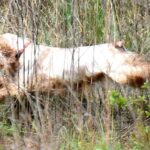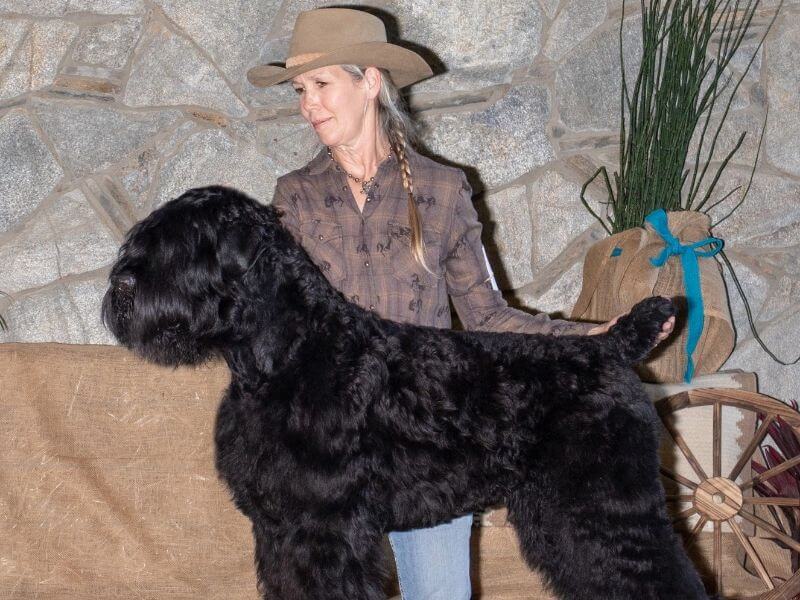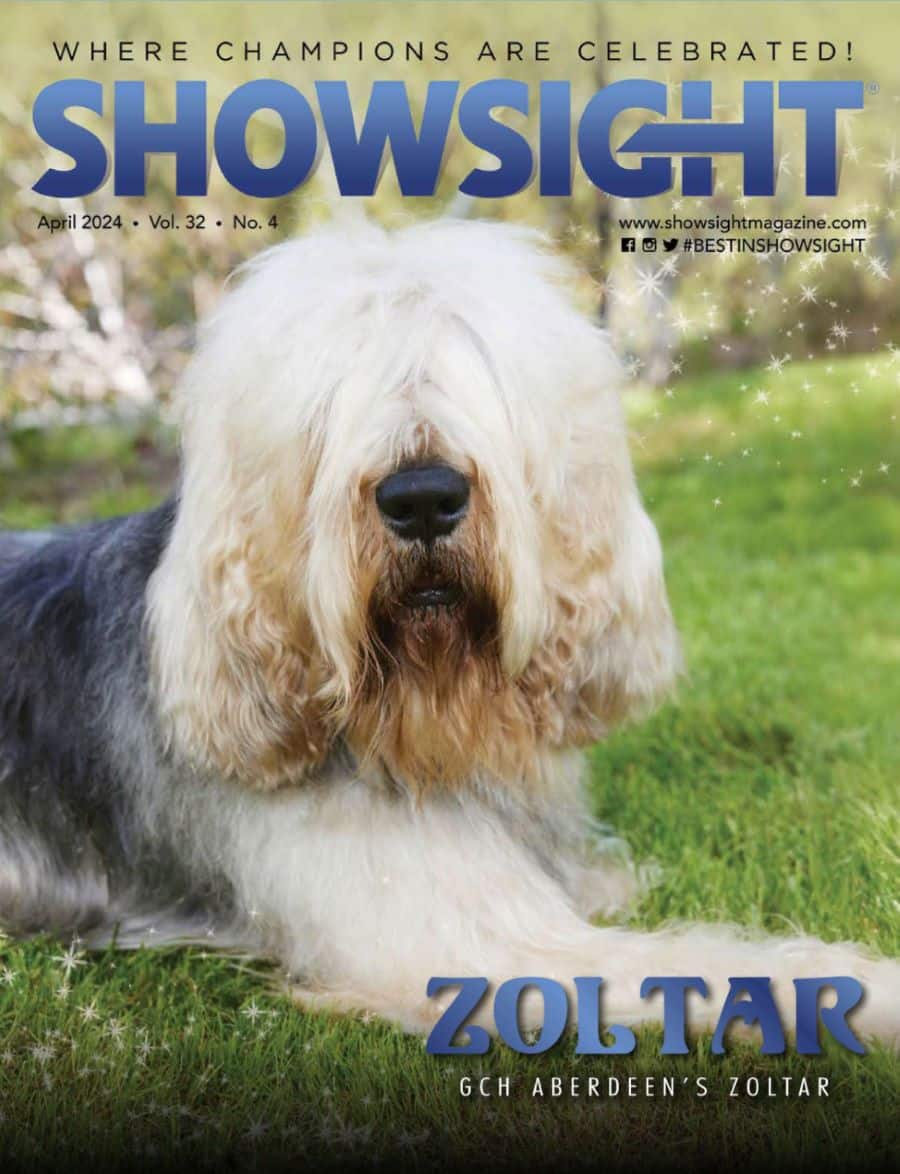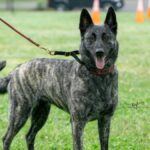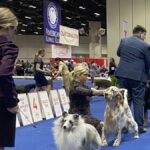Interview with Dr. Christine Robinson, Breeder of Black Beard Black Russian Terriers
Where do I live? How many years in dogs? How many years as a breeder?
Dr. Christine Robinson: My husband, Stewart, and I live in sunny Southern California, where we were both born and raised. We have been involved in breeding dogs for nearly 40 years, having bred from four different AKC Groups. We have been showing Black Russian Terriers for 14 years. Our first litter of BRTs is just turning nine years old.
What is my kennel name? How many dogs do I currently keep?
Dr. Christine Robinson: Our AKC registered kennel name is Black Beard Black Russian Terriers. The name “Black Beard” is an homage to our first BRT, “Thatch,” who was named after Black Beard, the English pirate. We are proud participants of the AKC Breeder of Merit program with 100 percent of our litters and puppies having AKC registrations. We keep four dogs at home, and a few of our girls live close by and visit daily.
Which show dogs from the past have been my noteworthy winners?
Dr. Christine Robinson: Our first BRT is Grand Champion Bronze Ya Black Beard Iz Chigasovo TT CGC (Thatch). I think your first always has a special place in your heart, but I remain in awe of this almost 14-year-old patriarch. Thatch is Group-winning and Group-placing; he finished Top 20 in Breed in 2011 and Top 5 in 2016. As a veteran competing in the Best of Breed class, he finished No. 5 in the country and earned an invitation to Westminster Kennel Club Dog Show. Thatch remains the oldest Black Russian Terrier ever invited to Westminster. In 2017, Thatch was invited to the parent club’s first-ever Top 20 competition as a veteran dog.
The second dog I think about is now seven-year-old Grand Champion Bronze Odessa Ter’ Avalon For Black Beard. Odessa finished her championship very young. I brought her out and competed in between litters. Odessa is Group-winning and Group-placing; she has ranked in Breed and All-Breed as well as NOHS in multiple years. She was invited to the parent club’s Top 20 competition in 2019. This year, she is dual-qualified (Breed and NOHS) for the parent club’s Top 20 competition.
Black Beard’s Fairy Godmother CD PCD BN RI SWN CGC was not destined to win in the show ring, but she’s killing it everywhere else! “Anya” twice ranked No. 1 in Front & Finish magazine for Novice A&B (2021 & 2022). She ranked No. 1 for Rally Novice (2020) and No. 4 for Rally Intermediate (2021). She was High in Trial in Scent Work at the National Specialty in 2021. At the 2022 National Specialty, Anya was High in Trial in Rally and Obedience. She recently passed the AKC Temperament Test and earned her Farm Dog Certificate. Pending AKC confirmation, Anya will be Black Beard’s Fairy Godmother CD PCD BN RI SWN CGC ATT FDC. I couldn’t be more proud of Anya and her co-owner Amanda.
Which have been my most influential sires and dams?
Dr. Christine Robinson: Influential sires for me have been strongly related to one of the best kennels in Russia, Yuri & Irina Morozov’s Chigasovo Kennels. Thatch and his son, “Michael,” as well as Michael’s mom, “Fleur,” have all contributed significantly to our breeding program. All of these dogs lived long, healthy lives and are some of the best breed representatives I’ve had the privilege of breeding.
Can I talk a bit about my facilities? Where are my puppies whelped? How are they raised?
Dr. Christine Robinson: We work very carefully to make sure each of our dogs has a quality life. These are our family dogs. They live with us, swim in the pool with us, sleep on our bed, and sleep under my desk. It’s important to raise puppies in the same environment. This is an indoor breed that is very bonded to its family. Black Russian Terriers will not thrive in a “kennel” environment. They do not do well left alone outside or as dog number “__” in a large pack. The Black Russian is exceptionally intelligent (sometimes smarter than its owners) and needs to be engaged daily.
In our home, we have a room dedicated to puppy raising. I sleep in the whelping box with our babies until at least three weeks old. I use every imaginable science and technology available to me to raise happy, healthy puppies. We have an incubator and oxygenator to help support those first critical days of life. We use Early Neurological Stimulation (ENS) and Early Scent Introduction (ESI) to give our puppies a good start in life. Our veterinarian is a successful show person and breeder. We follow experts’ advice and use techniques that many breeders are familiar with, including Pat Hastings’ Puppy Puzzle and Puppy Development programs along with extensive socialization, and exposure to unique environments and different kinds of animals.
Our puppy families can tell you that I’m a bit obsessed with everything that these babies do. Every litter is special, and every puppy is special. We make sure they get the very best of everything, including individual attention. All of our puppies go home with an AKC registration, prepaid AKC Reunite microchip, wellness exam and clear fecal results, OFA CAER eye exam, Embark DNA testing, and a nomograph for their vaccine schedule. In addition to all of that, we Volhard test the puppies at seven weeks and begin structural evaluation at eight weeks.
What is my “process” for selecting Show Puppies? Performance Puppies?
Dr. Christine Robinson: That process really starts from birth. Based on experience, I can often see which puppies will make the shortlist for show prospects when they are born. After that, personality traits and characteristics develop over the next several weeks. We can see true personalities developing as early as five weeks. As they physically develop and mature, I introduce physical opportunities to explore their environment. Scent games are a big favorite. We also use toys and tools that they might find in Performance Sports such as a tunnel, dumbbell, orange cone, platform, swing, and balance discs. They learn to swim beginning around 7 weeks with the aid of a small lifejacket. We match a prospective family’s lifestyle with a compatible puppy. This includes choosing just the right puppy for a family that enjoys Therapy Work.
Between our observations, results of the puppy aptitude evaluations, and structural evaluations by our breeder-veterinarian, at least one other breeder, and a judge, we are able to select which puppies would be suitable for each family whether that is show, performance, or personal companion.
Do I compete in Performance Events? In Parent Club Tests & Trials?
Dr. Christine Robinson: Our dogs have titles in Temperament, Rally, Obedience, and Scent Work. A few also participate in Therapy Work. Presently, the parent club does not have tests and trials. But, we can boast breeding a girl who earned High in Trial at the parent club’s first-ever Scent Trials at the National Specialty in 2021. That same girl also earned High in Trial for Rally and Obedience at the 2022
National Specialty.
Is “performance” part of my decision-making when it comes to breeding?
Dr. Christine Robinson: Yes, performance or “work” is an important part of our breeding program. My first dog, Thatch, comes from multiple generations of protection-titled dogs in Russia. We have used many sires who have Performance or Protection titles or are first generation from that work. It’s critical to preserve the working type, temperament, and ability. Let’s face it, no one is going to be excited about breeding an aggressive family dog, but it is important to preserve their natural ability to be protective while controlled and to keep the intelligence that allows them to excel at many different activities.
How would I define “conditioning” as it relates to my breed?
Dr. Christine Robinson: Conditioning is mental and physical. By nature, the Black Russian Terrier is an aloof guard dog. Mental conditioning comes in socialization and compliance. I expect that a dog may not relish intrusion into its personal space (e.g., at the vet or in the show ring) and yet I expect that a dog will comply with my request to stand for exam without anxiety or threatening a person or another dog. The sound mind must be introduced to a variety of experiences. Opportunities to work together calmly and safely are provided regularly and at different stages of mental and physical development.
Physical conditioning relates to both the coat and the body. The coat needs a lot of attention to develop appropriate furnishings and protect the dog from temperature extremes (heat and cold). Genetics and nutrition play a significant part in developing the correct coat. A show groom doesn’t start with a bath and a pair of scissors. We can’t groom what isn’t there. The skin and coat must be worked and prepared over many months.
The other part of physical conditioning is about the body. Beginning with a structurally balanced dog, physical conditioning begins as random play action in a puppy and develops into swimming and treadmilling as the dog matures. This is a well-muscled breed, but no amount of conditioning will give a dog the correct “reach and drive” required to cover ground while conserving energy. It’s important to start with a physically sound and structurally correct dog. Weight management is important to maintain a good topline and reduce joint stress on an already heavy frame.
Are there any health-related concerns in my breed? Any special nutritional needs?
Dr. Christine Robinson: The most significant health concern in the breed is joint health, similar to any other large breed dog. Feeding a well-balanced diet is important to maintaining a healthy weight and quality coat. With a dense, double coat, it’s not always easy to see body changes, so the hands-on approach to weight management is important. Don’t let dogs get overweight. A fat puppy is the first step to a lifetime of joint problems.
The thick double coat can also cause health problems if not properly maintained. Poor grooming practices can lead to ear infections and hot spots. Keeping nails short and shaving hair between the pads will help to give solid footing, even on slicker surfaces. The other significant health concerns are genetic. There are DNA tests available to help determine if individual dogs are at risk for hyperuricosuria (HUU), progressive retinal atrophy-progressive rod-cone degeneration (PRA-prcd), and juvenile laryngeal paralysis and polyneuropathy (JLPP).
Do I think my breed is supported by a sufficient number of preservation breeders?
Dr. Christine Robinson: No, the Black Russian Terrier is not supported by a sufficient number of preservation breeders. The truth is, there are only a few. I think this is something that is developing as the breeders, particularly newer breeders, are discovering the science behind and the benefit of preservation breeding. Preservation breeding is not about outcrossing or breeding your favorite dog. We have scientific tools that look at our genetic coefficient of inbreeding, our genetic diversity compared to the canine population, and a breed-specific genetic diversity study available through UC Davis, in addition to individual evaluation and pedigree and COI tools. It’s expensive and time-consuming to research and import sires and/or semen from foreign dogs. Not many breeders are willing to take the risks associated with surgical insemination. In general, breeders do not understand preservation breeding. Many other breeds do it better.
Is my breed well suited to be a family dog? Who are the best candidates to own my breed?
Dr. Christine Robinson: That’s debatable. I think it depends on the individual family and the personality of the dog. Some puppies are clearly going to be well-suited to a family with active children, and other puppies will thrive better in an adult-only home. This breed is highly adaptable and capable of living in a variety of conditions, but individual dogs will thrive in an environment that encourages their natural tendencies. The breeder should be best-suited to pairing a puppy and a family.
I don’t think there is one perfect family composition for a Black Russian Terrier. I like adult families with adult children and visiting grandchildren. I’ve also seen single adults do very well with a BRT. Very active, young families may find it difficult to put in the necessary time to develop a well-socialized Black Russian, and yet I have seen families do an amazing job managing the needs of the puppy and the children. We can only do so much from the whelping box… The next two to three years are critical in the development of a stable and balanced dog. Given a sound puppy, the breed is capable of adapting to a wide variety of families.
What is the biggest misconception about my breed? What is my breed’s best-kept secret?
Dr. Christine Robinson: I think the biggest misconception about the breed is that they are big teddy bears. I can remember wondering if my 1-1/2-year-old female was cable of being a “real” Black Russian Terrier. When a moment presented itself, she stepped up to the mark in real time. I was shocked at how quickly she reacted to the encroachment of a stranger. Fleur has always been a sweet, friendly, loving, empathetic girl, kind to people in need of a hug; always calm at the vet or a dog show. When circumstances were just right, she turned into a deliberate, intimidating protector. My heart filled with pride as I knew I would always be safe in her care.
I think the best-kept secret about the breed is that they are funny! This serious guard dog can get up to some funny tricks; they are absolute clowns in the comfort of their people.
If I could share a comment or two with judges of my breed, what would I like to say to them?
Dr. Christine Robinson: Thank you for taking the time to learn about this magnificent breed! Judging the Black Russian Terrier can be a thrilling experience when you put your hands on a well-muscled, balanced dog. There is no mistaking a balanced dog with reach and drive as it effortlessly moves around the ring. Don’t feel pressured to go over a dog if you don’t feel safe or if the handler doesn’t have control of the head. It’s difficult to read a Black Russian Terrier. Take your safety—and the safety of all judges after you—seriously. Excitability and excessive shyness are serious faults. If a young dog isn’t ready to stand for exam, it isn’t ready for the show ring. The Black Russian Terrier is a calm, confident, self-assured large breed dog.
Do I have any words of wisdom to pass along to newer breeders?
Dr. Christine Robinson: Find a few mentors. Learn about breeding from experts; take classes and seminars. There is a lot to learn about breeding, care of the stud dog and brood bitch, and whelping a litter and raising puppies, and none of this is breed-specific. Talk to breeders (in any breed) about the goals for their breeding program. Do you know what you want to accomplish? Do you know which resources are available to you? Ideally, you will find a mentor in your dog’s breeders, but if you don’t, reach out to the parent club or AKC for help. There are a lot of resources available.
For a bit of fun, what’s the most amusing thing I’ve ever experienced with a Working Dog?
Dr. Christine Robinson: I was new to the breed and showing my first Black Russian who was about nine months old at the time. The AKC show was held in a public park. Some very nice and friendly people complimented my dog and then asked, “How can he see with all that hair in his eyes?” referring to his fall. I proudly stated, “Oh, he can see” as my puppy simultaneously walked into the side of a park bench. My first Black Russian could be quite the clown, going around the ring on two legs and biting falling raindrops. He loves showing. As far as Thatch is concerned, a dog show is just a party thrown in his honor and all the food and attention is for him.
